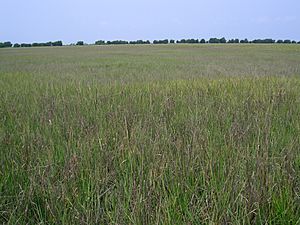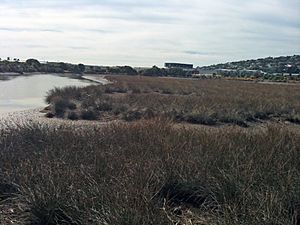Salt marsh facts for kids
A salt marsh is a special place where land meets the sea. It's a coastal area that gets flooded regularly by the ocean's tides. These areas are full of plants that can handle salty water, like grasses and small shrubs.
These tough plants help keep the marsh stable. They trap sediment (like mud and sand) and hold it together with their roots. Salt marshes are very important for ocean life. They provide food and nutrients to coastal waters. They also offer a safe home for many land animals and help protect the coast from storms.
Contents
What is a Salt Marsh?

Salt marshes are found on quiet coastlines. These are places where the water doesn't have strong waves. You can find them in cooler parts of the world, like temperate and polar regions.
They often grow on mud or sand flats. These flats get their mud and sand from rivers and streams. Salt marshes usually form in sheltered spots. Examples include riverbanks, estuaries, and behind barrier islands.
In warmer, tropical and sub-tropical areas, you won't find salt marshes. Instead, you'll find mangroves. Mangroves are similar, but they are dominated by salt-tolerant trees, not grasses.
Most salt marshes are quite flat and wide. This makes them popular places for people to live nearby.
Salt marshes can be found in different kinds of coastal areas.
- Deltaic marshes are near large rivers. You can see them in places like the Rhône delta in France. The Mississippi Delta in the United States also has many.
- In New Zealand, most salt marshes are at the end of estuaries. They are in areas with calm water and lots of sediment.
- Back-barrier marshes form behind barrier islands. They are common along the eastern coast of the United States.
- Large, shallow bays can also have salt marshes. Examples include Morecambe Bay in Britain and the Bay of Fundy in North America.
Salt marshes are sometimes part of lagoons. The Venetian Lagoon in Italy is a good example. It has many animals and plants that live in this type of ecosystem.
Life in a Salt Marsh
Salt marshes are full of life. They have a complex food web.
- Producers are plants like grasses, algae, and tiny organisms. They make their own food using sunlight.
- Primary consumers eat the producers. These include small animals like zooplankton, crabs, snails, and insects.
- Secondary consumers eat the primary consumers. These can be fish and birds.
The calm water and tall grasses make a safe home for animals. Many ocean fish use salt marshes as nurseries. Their young fish grow up here before swimming out to the open ocean.
Birds also raise their babies in the tall grasses. The marsh protects them from predators. It also provides plenty of food. Birds can find fish trapped in pools, insects, shellfish, and worms.
Where are Salt Marshes Found?
Scientists mapped salt marshes in 99 countries around the world in 2017. They found about 5.5 million hectares of mapped salt marsh. This is like a huge area of land!
The biggest salt marshes are outside of tropical areas. You can find many along the coasts, bays, and estuaries of the North Atlantic Ocean.
How Salt Marshes Form
Salt marshes start as flat areas of mud or sand. These areas are called mudflats.
- First, sediment (mud and sand) builds up on the tidal flats. This makes the ground higher.
- As the ground gets higher, it gets flooded less often by the tides.
- Then, special pioneer species of plants can start to grow. These are the first plants to colonize the area. They might grow from seeds or parts of roots.
- When rivers flow onto these flat areas, the water slows down. This causes the mud and sand floating in the water to settle. The rising tide also helps this process.
- Tiny sticky mats of blue-green algae can also help. They trap small mud and clay particles. This makes the ground stronger and helps more sediment build up.
- Plants like Salicornia (glasswort) start to grow. They trap even more sediment around their stems and leaves.
- These plants form small muddy mounds. Over time, these mounds join together to create larger flat areas. Their roots grow underground and hold the sediment in place.
- Once plants are established, the marsh surface can grow quickly. This means the area gets flooded less often and for shorter times.
- As the marsh gets higher, different types of plants can move in. These plants prefer higher ground. This leads to different groups of plants growing in different parts of the marsh.
Images for kids
-
An Atlantic coastal salt marsh in Connecticut.
-
High marsh in the Marine Park Salt Marsh Nature Center in Brooklyn, New York.
-
Bloody Marsh in Georgia, USA.
-
Spartina alterniflora (Saltmarsh Cordgrass). It's native to the eastern United States.
-
Crabs, like the tunnelling mud crab Helice crassa from New Zealand, play a special role in salt marsh ecosystems.
-
Glasswort (Salicornia spp.), a plant found in the high marsh zone.
-
Common reed (Phragmites australis), a plant that can take over marshes in the northeastern United States.
See also
 In Spanish: Marisma salina para niños
In Spanish: Marisma salina para niños












